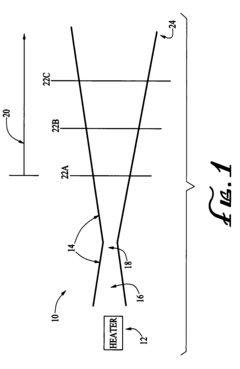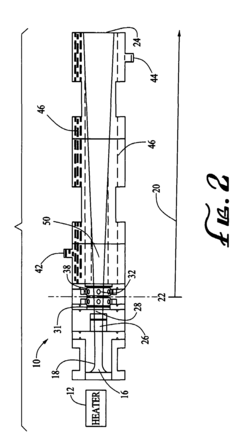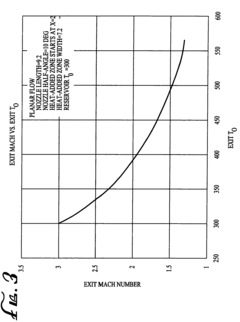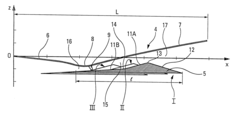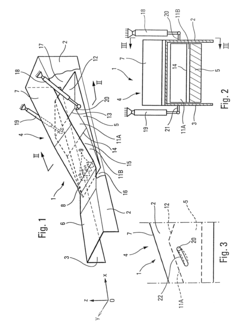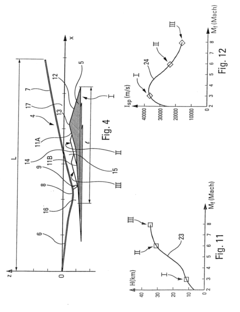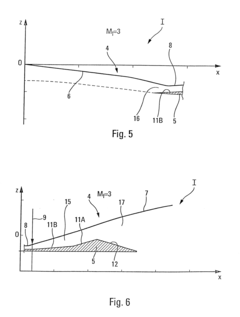Investigating the Multi-role Capacities of Scramjet-Powered Reconnaissance
AUG 13, 20258 MIN READ
Generate Your Research Report Instantly with AI Agent
Patsnap Eureka helps you evaluate technical feasibility & market potential.
Scramjet Tech Evolution
The evolution of scramjet technology has been marked by significant milestones and breakthroughs over the past several decades. Initially conceptualized in the 1950s, scramjet engines represented a revolutionary approach to hypersonic propulsion, promising to overcome the limitations of traditional jet engines at extreme speeds.
The 1960s and 1970s saw intensive theoretical work and early experimental efforts, primarily led by NASA and the U.S. Air Force. These early stages focused on understanding the complex fluid dynamics and combustion processes at hypersonic speeds. The X-15 program, while not a scramjet itself, provided crucial data on hypersonic flight that would later inform scramjet development.
The 1980s marked a turning point with the National Aerospace Plane (NASP) program, which aimed to develop a single-stage-to-orbit vehicle using scramjet propulsion. Although the program was eventually cancelled, it significantly advanced scramjet technology and materials science.
In the 1990s and early 2000s, several successful ground tests were conducted, demonstrating the viability of scramjet engines. The NASA Hyper-X program, culminating in the X-43A flights in 2004, achieved the first successful scramjet-powered flight, reaching speeds of Mach 9.6.
The 2010s saw further advancements, with the X-51 Waverider program demonstrating sustained scramjet flight at Mach 5 for over three minutes in 2013. This period also witnessed increased international interest, with countries like Russia, China, and India investing heavily in scramjet research.
Recent years have focused on improving scramjet efficiency, durability, and operational flexibility. Advancements in materials science, such as high-temperature ceramics and carbon-carbon composites, have addressed some of the extreme thermal challenges faced by scramjet engines.
The integration of scramjet technology with reconnaissance capabilities represents a new frontier. This combination promises to revolutionize high-speed, high-altitude intelligence gathering. Current research is exploring ways to optimize scramjet designs for extended flight times and improved maneuverability, crucial for reconnaissance missions.
Looking forward, the trajectory of scramjet technology is likely to focus on enhancing reliability, expanding the operational envelope, and reducing costs. The potential for multi-role capacities, particularly in reconnaissance, is driving research into more versatile scramjet designs capable of operating across a wider range of speeds and altitudes.
The 1960s and 1970s saw intensive theoretical work and early experimental efforts, primarily led by NASA and the U.S. Air Force. These early stages focused on understanding the complex fluid dynamics and combustion processes at hypersonic speeds. The X-15 program, while not a scramjet itself, provided crucial data on hypersonic flight that would later inform scramjet development.
The 1980s marked a turning point with the National Aerospace Plane (NASP) program, which aimed to develop a single-stage-to-orbit vehicle using scramjet propulsion. Although the program was eventually cancelled, it significantly advanced scramjet technology and materials science.
In the 1990s and early 2000s, several successful ground tests were conducted, demonstrating the viability of scramjet engines. The NASA Hyper-X program, culminating in the X-43A flights in 2004, achieved the first successful scramjet-powered flight, reaching speeds of Mach 9.6.
The 2010s saw further advancements, with the X-51 Waverider program demonstrating sustained scramjet flight at Mach 5 for over three minutes in 2013. This period also witnessed increased international interest, with countries like Russia, China, and India investing heavily in scramjet research.
Recent years have focused on improving scramjet efficiency, durability, and operational flexibility. Advancements in materials science, such as high-temperature ceramics and carbon-carbon composites, have addressed some of the extreme thermal challenges faced by scramjet engines.
The integration of scramjet technology with reconnaissance capabilities represents a new frontier. This combination promises to revolutionize high-speed, high-altitude intelligence gathering. Current research is exploring ways to optimize scramjet designs for extended flight times and improved maneuverability, crucial for reconnaissance missions.
Looking forward, the trajectory of scramjet technology is likely to focus on enhancing reliability, expanding the operational envelope, and reducing costs. The potential for multi-role capacities, particularly in reconnaissance, is driving research into more versatile scramjet designs capable of operating across a wider range of speeds and altitudes.
Recon Market Analysis
The reconnaissance market for scramjet-powered vehicles is experiencing significant growth, driven by increasing global security concerns and the need for advanced intelligence gathering capabilities. This market segment is characterized by high-value, low-volume contracts, typically awarded by government agencies and military organizations.
The demand for scramjet-powered reconnaissance platforms stems from their unique ability to operate at hypersonic speeds, providing rapid response times and enhanced survivability in contested environments. These vehicles offer advantages over traditional reconnaissance assets, including reduced vulnerability to anti-aircraft systems and the capacity to cover vast distances quickly.
Market analysis indicates a strong focus on developing multi-role capabilities for scramjet-powered reconnaissance vehicles. This trend is driven by the desire to maximize the utility and cost-effectiveness of these advanced platforms. Potential multi-role applications include intelligence, surveillance, and reconnaissance (ISR) missions, strategic strike capabilities, and even rapid global transport of critical payloads.
The market for scramjet-powered reconnaissance is currently dominated by a few key players, primarily large aerospace and defense contractors with significant research and development resources. However, there is growing interest from emerging companies and international collaborations, which are likely to reshape the competitive landscape in the coming years.
Geographically, the market is concentrated in countries with advanced aerospace industries and substantial defense budgets. The United States, China, and Russia are at the forefront of scramjet technology development, with other nations like India, Japan, and several European countries also investing in this field.
Market forecasts suggest steady growth in the scramjet-powered reconnaissance sector over the next decade. This growth is expected to be fueled by ongoing geopolitical tensions, the need for rapid global reach capabilities, and advancements in hypersonic technologies that enhance the feasibility and effectiveness of these platforms.
Key market drivers include the increasing emphasis on space-based assets and the growing importance of prompt global strike capabilities. Additionally, the dual-use potential of scramjet technology for both military and civilian applications is attracting interest from commercial entities, potentially expanding the market beyond traditional defense sectors.
The demand for scramjet-powered reconnaissance platforms stems from their unique ability to operate at hypersonic speeds, providing rapid response times and enhanced survivability in contested environments. These vehicles offer advantages over traditional reconnaissance assets, including reduced vulnerability to anti-aircraft systems and the capacity to cover vast distances quickly.
Market analysis indicates a strong focus on developing multi-role capabilities for scramjet-powered reconnaissance vehicles. This trend is driven by the desire to maximize the utility and cost-effectiveness of these advanced platforms. Potential multi-role applications include intelligence, surveillance, and reconnaissance (ISR) missions, strategic strike capabilities, and even rapid global transport of critical payloads.
The market for scramjet-powered reconnaissance is currently dominated by a few key players, primarily large aerospace and defense contractors with significant research and development resources. However, there is growing interest from emerging companies and international collaborations, which are likely to reshape the competitive landscape in the coming years.
Geographically, the market is concentrated in countries with advanced aerospace industries and substantial defense budgets. The United States, China, and Russia are at the forefront of scramjet technology development, with other nations like India, Japan, and several European countries also investing in this field.
Market forecasts suggest steady growth in the scramjet-powered reconnaissance sector over the next decade. This growth is expected to be fueled by ongoing geopolitical tensions, the need for rapid global reach capabilities, and advancements in hypersonic technologies that enhance the feasibility and effectiveness of these platforms.
Key market drivers include the increasing emphasis on space-based assets and the growing importance of prompt global strike capabilities. Additionally, the dual-use potential of scramjet technology for both military and civilian applications is attracting interest from commercial entities, potentially expanding the market beyond traditional defense sectors.
Scramjet Challenges
Scramjet technology faces several significant challenges that hinder its widespread adoption and implementation. One of the primary obstacles is the extreme operating conditions required for scramjet engines. These engines function optimally at hypersonic speeds, typically above Mach 5, which subjects the materials and components to intense heat and pressure. Developing materials that can withstand these extreme conditions while maintaining structural integrity and performance is a major engineering challenge.
Another critical issue is the complexity of fuel injection and combustion processes in scramjet engines. At hypersonic speeds, the airflow through the engine is supersonic, leaving extremely limited time for fuel mixing and combustion. This necessitates precise and efficient fuel injection systems and combustion chamber designs to achieve stable and sustained combustion. The development of advanced computational fluid dynamics models and experimental techniques is crucial for optimizing these processes.
Control and stability present additional challenges for scramjet-powered vehicles. The transition from subsonic to hypersonic flight regimes involves complex aerodynamic phenomena, and maintaining stable flight throughout this transition is a significant technical hurdle. Furthermore, the integration of scramjet propulsion with airframe design requires careful consideration of thermal management, weight distribution, and overall vehicle aerodynamics.
The development of reliable ignition systems for scramjet engines is another area of concern. Traditional ignition methods may not be effective at hypersonic speeds, necessitating the exploration of novel ignition techniques such as plasma-assisted combustion or shock-induced ignition. These systems must be capable of initiating and sustaining combustion under the extreme conditions present in scramjet engines.
Scaling scramjet technology for practical applications poses additional challenges. While small-scale demonstrators have shown promise, scaling up to full-size vehicles capable of carrying significant payloads or performing extended missions introduces new complexities in terms of thermal management, structural design, and overall system integration. The development of efficient cooling systems and heat-resistant materials becomes even more critical at larger scales.
Finally, the testing and validation of scramjet technology present unique challenges due to the extreme operating conditions. Ground-based testing facilities capable of simulating hypersonic flight conditions are limited and expensive to operate. Flight testing of scramjet-powered vehicles is equally challenging, requiring specialized launch systems and extensive safety precautions. These factors contribute to the high cost and long development cycles associated with scramjet technology, making it difficult to rapidly iterate and improve designs.
Another critical issue is the complexity of fuel injection and combustion processes in scramjet engines. At hypersonic speeds, the airflow through the engine is supersonic, leaving extremely limited time for fuel mixing and combustion. This necessitates precise and efficient fuel injection systems and combustion chamber designs to achieve stable and sustained combustion. The development of advanced computational fluid dynamics models and experimental techniques is crucial for optimizing these processes.
Control and stability present additional challenges for scramjet-powered vehicles. The transition from subsonic to hypersonic flight regimes involves complex aerodynamic phenomena, and maintaining stable flight throughout this transition is a significant technical hurdle. Furthermore, the integration of scramjet propulsion with airframe design requires careful consideration of thermal management, weight distribution, and overall vehicle aerodynamics.
The development of reliable ignition systems for scramjet engines is another area of concern. Traditional ignition methods may not be effective at hypersonic speeds, necessitating the exploration of novel ignition techniques such as plasma-assisted combustion or shock-induced ignition. These systems must be capable of initiating and sustaining combustion under the extreme conditions present in scramjet engines.
Scaling scramjet technology for practical applications poses additional challenges. While small-scale demonstrators have shown promise, scaling up to full-size vehicles capable of carrying significant payloads or performing extended missions introduces new complexities in terms of thermal management, structural design, and overall system integration. The development of efficient cooling systems and heat-resistant materials becomes even more critical at larger scales.
Finally, the testing and validation of scramjet technology present unique challenges due to the extreme operating conditions. Ground-based testing facilities capable of simulating hypersonic flight conditions are limited and expensive to operate. Flight testing of scramjet-powered vehicles is equally challenging, requiring specialized launch systems and extensive safety precautions. These factors contribute to the high cost and long development cycles associated with scramjet technology, making it difficult to rapidly iterate and improve designs.
Current Scramjet Recon
01 Scramjet engine design for reconnaissance aircraft
Advanced scramjet engine designs optimized for reconnaissance aircraft, focusing on high-speed, high-altitude performance. These engines enable sustained hypersonic flight, allowing for rapid deployment and extended mission durations. The designs incorporate innovative fuel injection systems and thermal management solutions to maintain efficiency at extreme speeds.- Scramjet engine design for reconnaissance aircraft: Advanced scramjet engine designs optimized for reconnaissance aircraft, focusing on high-speed capabilities and efficient fuel consumption. These engines enable sustained hypersonic flight, allowing for rapid deployment and extended mission durations in multi-role capacities.
- Multi-role sensor integration for reconnaissance: Integration of various sensor systems in scramjet-powered reconnaissance aircraft to enhance multi-role capabilities. This includes advanced imaging, electronic intelligence, and communication systems, enabling the aircraft to perform diverse missions such as surveillance, target acquisition, and data relay.
- Aerodynamic configurations for hypersonic reconnaissance: Specialized aerodynamic designs tailored for scramjet-powered reconnaissance aircraft, optimizing performance at hypersonic speeds while maintaining stability and maneuverability. These configurations also consider stealth characteristics and heat management for enhanced survivability.
- Adaptive control systems for multi-role operations: Advanced control systems that enable scramjet-powered reconnaissance aircraft to adapt to various mission profiles and environmental conditions. These systems optimize engine performance, flight characteristics, and sensor operations to enhance multi-role capabilities across different operational scenarios.
- Thermal management for sustained hypersonic flight: Innovative thermal management solutions to address the extreme heat generated during sustained hypersonic flight of scramjet-powered reconnaissance aircraft. These systems ensure the integrity of critical components and enable extended mission durations in multi-role capacities.
02 Multi-role capabilities integration
Integration of various systems to enable multi-role capabilities in scramjet-powered aircraft. This includes adaptable payload configurations, modular sensor suites, and reconfigurable mission systems. The design allows for quick transition between reconnaissance, strike, and electronic warfare roles, maximizing operational flexibility.Expand Specific Solutions03 Advanced sensor and communication systems
Cutting-edge sensor and communication systems specifically designed for scramjet-powered reconnaissance platforms. These include high-resolution imaging systems, advanced radar technologies, and secure, high-bandwidth data links. The systems are optimized to operate effectively at hypersonic speeds and transmit real-time intelligence data.Expand Specific Solutions04 Thermal protection and materials innovation
Development of advanced thermal protection systems and materials to withstand the extreme temperatures encountered during hypersonic flight. This includes novel ablative materials, active cooling systems, and heat-resistant alloys that maintain structural integrity and reduce the aircraft's thermal signature.Expand Specific Solutions05 Autonomous operation and AI integration
Implementation of autonomous operation capabilities and artificial intelligence systems in scramjet-powered reconnaissance platforms. This includes advanced flight control algorithms, mission planning software, and AI-driven decision-making systems that enhance the aircraft's ability to operate independently in complex environments and adapt to changing mission parameters.Expand Specific Solutions
Aerospace Leaders
The field of scramjet-powered reconnaissance is in an early developmental stage, with significant potential for growth as nations seek advanced aerospace capabilities. The market size is relatively small but expanding, driven by military and space exploration applications. Technologically, scramjet propulsion remains challenging, with only a few successful demonstrations globally. Key players like the National University of Defense Technology, Harbin Institute of Technology, and Beihang University are leading China's efforts, while IBM and X Development LLC contribute to advanced computing and innovative design aspects. International collaboration is limited due to the technology's strategic nature, creating a competitive landscape dominated by national research institutions and specialized aerospace companies.
National University of Defense Technology
Technical Solution: The National University of Defense Technology (NUDT) has made significant advancements in scramjet-powered reconnaissance technology. Their research focuses on developing multi-role capacities for hypersonic vehicles, integrating advanced propulsion systems with cutting-edge sensor technologies. NUDT's approach involves a dual-mode scramjet engine capable of operating efficiently at both high and low speeds, allowing for versatile mission profiles[1]. The university has also developed advanced thermal protection systems to withstand the extreme temperatures encountered during hypersonic flight, utilizing novel ceramic matrix composites[2]. Additionally, NUDT has pioneered the integration of compact, high-resolution synthetic aperture radar (SAR) systems specifically designed for hypersonic platforms, enabling all-weather reconnaissance capabilities[3].
Strengths: Strong expertise in hypersonic technologies, advanced propulsion systems, and integrated sensor suites. Weaknesses: Potential limitations in international collaboration due to defense-related nature of research.
Beijing Power Machinery Institute
Technical Solution: Beijing Power Machinery Institute (BPMI) has made substantial progress in scramjet-powered reconnaissance technology, focusing on the development of efficient and reliable propulsion systems. Their research emphasizes the creation of variable-geometry inlet designs that optimize airflow across a wide range of Mach numbers, enhancing the multi-role capabilities of scramjet-powered vehicles[1]. BPMI has also developed advanced fuel injection and mixing techniques, utilizing supercritical hydrocarbon fuels to improve combustion efficiency and extend operational range[2]. The institute's work on adaptive control systems for scramjet engines allows for real-time adjustment of combustion parameters, ensuring optimal performance across diverse mission profiles[3]. Furthermore, BPMI has integrated advanced materials science into their designs, employing high-temperature alloys and ceramic composites to enhance the durability and reliability of scramjet components in extreme operating conditions[4].
Strengths: Expertise in propulsion systems, advanced materials, and adaptive control technologies. Weaknesses: Potential challenges in scaling up technologies for full-scale operational deployment.
Key Scramjet Patents
Method for using variable supersonic Mach number air heater utilizing supersonic combustion
PatentInactiveUS7296396B1
Innovation
- A supersonic combustion heater apparatus that varies exit plane Mach numbers through strategic fuel injection and flame stabilization in a fixed geometry nozzle, enhancing high enthalpy flow and flame stability without using expensive film cooled nozzles, allowing for mode transition testing in air-breathing propulsion systems.
Ramjet for a supersonic and hypersonic aircraft
PatentInactiveUS6672068B1
Innovation
- A ramjet design featuring a sliding lower wall with a movable V-profiled structure that adjusts the oxidant inlet and combustion chamber geometry by translating one wall, eliminating the need for complex articulation systems and actuators, allowing for optimal combustion at both subsonic and supersonic speeds by modifying the cross-section and nozzle geometry in response to changing Mach numbers.
Hypersonic Regulations
The development and deployment of hypersonic technologies, particularly scramjet-powered reconnaissance systems, have necessitated the establishment of comprehensive regulatory frameworks. These regulations aim to address the unique challenges posed by hypersonic flight, including safety concerns, environmental impact, and international security implications.
At the national level, countries with advanced hypersonic programs have implemented specific guidelines for research, development, and testing of hypersonic vehicles. These regulations often focus on safety protocols, environmental assessments, and noise mitigation strategies. For instance, the United States has established stringent safety standards for hypersonic flight tests, requiring extensive pre-flight simulations and risk assessments.
Internationally, efforts are underway to develop a cohesive regulatory approach to hypersonic technologies. The United Nations Office for Outer Space Affairs (UNOOSA) has initiated discussions on the potential need for new international treaties or amendments to existing space law to address hypersonic flight. These discussions aim to establish norms for the responsible use of hypersonic technologies and prevent their potential weaponization.
Environmental regulations play a crucial role in the development of hypersonic technologies. Scramjet engines, while efficient at high speeds, produce significant emissions at lower altitudes. Regulatory bodies are working to establish emission standards specific to hypersonic vehicles, balancing technological advancement with environmental protection.
The dual-use nature of hypersonic technologies, particularly in reconnaissance applications, has led to the implementation of export control regulations. Many countries have classified hypersonic technologies as sensitive items subject to strict export controls, limiting the transfer of related knowledge and components to prevent proliferation.
Airspace management regulations are also evolving to accommodate hypersonic flight. Aviation authorities are developing new protocols for integrating hypersonic vehicles into existing air traffic control systems, addressing challenges such as rapid trajectory changes and extended sonic boom corridors.
As the field of hypersonic technology continues to advance, regulatory frameworks are expected to evolve. Future regulations may focus on areas such as debris mitigation for hypersonic vehicles, international overflight agreements, and standardized testing protocols for scramjet engines. The ongoing dialogue between policymakers, industry stakeholders, and scientific experts will be crucial in shaping a regulatory environment that fosters innovation while ensuring safety and global stability.
At the national level, countries with advanced hypersonic programs have implemented specific guidelines for research, development, and testing of hypersonic vehicles. These regulations often focus on safety protocols, environmental assessments, and noise mitigation strategies. For instance, the United States has established stringent safety standards for hypersonic flight tests, requiring extensive pre-flight simulations and risk assessments.
Internationally, efforts are underway to develop a cohesive regulatory approach to hypersonic technologies. The United Nations Office for Outer Space Affairs (UNOOSA) has initiated discussions on the potential need for new international treaties or amendments to existing space law to address hypersonic flight. These discussions aim to establish norms for the responsible use of hypersonic technologies and prevent their potential weaponization.
Environmental regulations play a crucial role in the development of hypersonic technologies. Scramjet engines, while efficient at high speeds, produce significant emissions at lower altitudes. Regulatory bodies are working to establish emission standards specific to hypersonic vehicles, balancing technological advancement with environmental protection.
The dual-use nature of hypersonic technologies, particularly in reconnaissance applications, has led to the implementation of export control regulations. Many countries have classified hypersonic technologies as sensitive items subject to strict export controls, limiting the transfer of related knowledge and components to prevent proliferation.
Airspace management regulations are also evolving to accommodate hypersonic flight. Aviation authorities are developing new protocols for integrating hypersonic vehicles into existing air traffic control systems, addressing challenges such as rapid trajectory changes and extended sonic boom corridors.
As the field of hypersonic technology continues to advance, regulatory frameworks are expected to evolve. Future regulations may focus on areas such as debris mitigation for hypersonic vehicles, international overflight agreements, and standardized testing protocols for scramjet engines. The ongoing dialogue between policymakers, industry stakeholders, and scientific experts will be crucial in shaping a regulatory environment that fosters innovation while ensuring safety and global stability.
Dual-Use Implications
The dual-use implications of scramjet-powered reconnaissance technology are significant and far-reaching, encompassing both military and civilian applications. In the military domain, scramjet-powered reconnaissance platforms offer unparalleled advantages in terms of speed, altitude, and range. These capabilities enable rapid deployment for intelligence gathering, surveillance, and reconnaissance missions in contested environments. The hypersonic speeds achievable by scramjet engines allow for quick ingress and egress from high-threat areas, reducing the risk of detection and interception.
From a civilian perspective, scramjet-powered reconnaissance platforms have potential applications in disaster response and environmental monitoring. The ability to rapidly deploy and cover vast areas makes these platforms ideal for assessing natural disasters, monitoring climate change effects, and conducting large-scale geological surveys. Additionally, the high-altitude capabilities of scramjet-powered vehicles could enhance global communications networks by serving as mobile relay stations or providing temporary coverage in remote areas.
The dual-use nature of this technology also presents challenges in terms of proliferation and arms control. The development of scramjet-powered reconnaissance platforms could lead to an escalation in military capabilities, potentially destabilizing existing strategic balances. Conversely, the civilian applications of this technology could foster international cooperation in scientific research and environmental protection.
The economic implications of scramjet-powered reconnaissance technology are substantial. Military investments in this technology could drive advancements in materials science, propulsion systems, and sensor technologies, with potential spillover effects into civilian industries. Commercial applications in aerospace and satellite industries could emerge, creating new market opportunities and driving innovation in high-speed transportation and space access.
Ethical considerations surrounding the dual-use nature of this technology must also be addressed. The potential for misuse or unintended consequences necessitates careful regulation and international agreements to govern the development and deployment of scramjet-powered reconnaissance platforms. Balancing national security interests with global stability and civilian benefits will be crucial in realizing the full potential of this technology while mitigating associated risks.
From a civilian perspective, scramjet-powered reconnaissance platforms have potential applications in disaster response and environmental monitoring. The ability to rapidly deploy and cover vast areas makes these platforms ideal for assessing natural disasters, monitoring climate change effects, and conducting large-scale geological surveys. Additionally, the high-altitude capabilities of scramjet-powered vehicles could enhance global communications networks by serving as mobile relay stations or providing temporary coverage in remote areas.
The dual-use nature of this technology also presents challenges in terms of proliferation and arms control. The development of scramjet-powered reconnaissance platforms could lead to an escalation in military capabilities, potentially destabilizing existing strategic balances. Conversely, the civilian applications of this technology could foster international cooperation in scientific research and environmental protection.
The economic implications of scramjet-powered reconnaissance technology are substantial. Military investments in this technology could drive advancements in materials science, propulsion systems, and sensor technologies, with potential spillover effects into civilian industries. Commercial applications in aerospace and satellite industries could emerge, creating new market opportunities and driving innovation in high-speed transportation and space access.
Ethical considerations surrounding the dual-use nature of this technology must also be addressed. The potential for misuse or unintended consequences necessitates careful regulation and international agreements to govern the development and deployment of scramjet-powered reconnaissance platforms. Balancing national security interests with global stability and civilian benefits will be crucial in realizing the full potential of this technology while mitigating associated risks.
Unlock deeper insights with Patsnap Eureka Quick Research — get a full tech report to explore trends and direct your research. Try now!
Generate Your Research Report Instantly with AI Agent
Supercharge your innovation with Patsnap Eureka AI Agent Platform!

